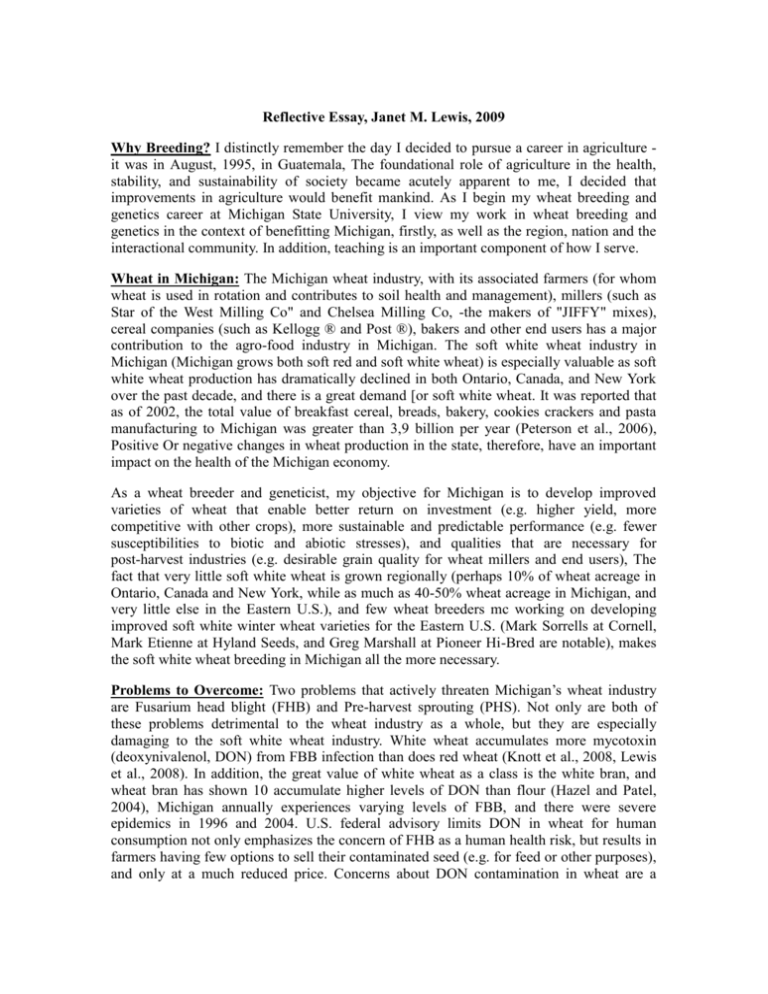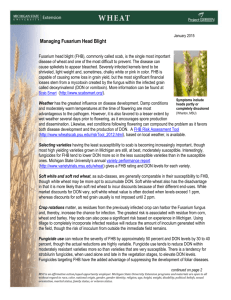Reflective Essay, Janet M. Lewis, 2009 Why Breeding? I distinctly
advertisement

Reflective Essay, Janet M. Lewis, 2009 Why Breeding? I distinctly remember the day I decided to pursue a career in agriculture it was in August, 1995, in Guatemala, The foundational role of agriculture in the health, stability, and sustainability of society became acutely apparent to me, I decided that improvements in agriculture would benefit mankind. As I begin my wheat breeding and genetics career at Michigan State University, I view my work in wheat breeding and genetics in the context of benefitting Michigan, firstly, as well as the region, nation and the interactional community. In addition, teaching is an important component of how I serve. Wheat in Michigan: The Michigan wheat industry, with its associated farmers (for whom wheat is used in rotation and contributes to soil health and management), millers (such as Star of the West Milling Co" and Chelsea Milling Co, -the makers of "JIFFY" mixes), cereal companies (such as Kellogg ® and Post ®), bakers and other end users has a major contribution to the agro-food industry in Michigan. The soft white wheat industry in Michigan (Michigan grows both soft red and soft white wheat) is especially valuable as soft white wheat production has dramatically declined in both Ontario, Canada, and New York over the past decade, and there is a great demand [or soft white wheat. It was reported that as of 2002, the total value of breakfast cereal, breads, bakery, cookies crackers and pasta manufacturing to Michigan was greater than 3,9 billion per year (Peterson et al., 2006), Positive Or negative changes in wheat production in the state, therefore, have an important impact on the health of the Michigan economy. As a wheat breeder and geneticist, my objective for Michigan is to develop improved varieties of wheat that enable better return on investment (e.g. higher yield, more competitive with other crops), more sustainable and predictable performance (e.g. fewer susceptibilities to biotic and abiotic stresses), and qualities that are necessary for post-harvest industries (e.g. desirable grain quality for wheat millers and end users), The fact that very little soft white wheat is grown regionally (perhaps 10% of wheat acreage in Ontario, Canada and New York, while as much as 40-50% wheat acreage in Michigan, and very little else in the Eastern U.S.), and few wheat breeders mc working on developing improved soft white winter wheat varieties for the Eastern U.S. (Mark Sorrells at Cornell, Mark Etienne at Hyland Seeds, and Greg Marshall at Pioneer Hi-Bred are notable), makes the soft white wheat breeding in Michigan all the more necessary. Problems to Overcome: Two problems that actively threaten Michigan’s wheat industry are Fusarium head blight (FHB) and Pre-harvest sprouting (PHS). Not only are both of these problems detrimental to the wheat industry as a whole, but they are especially damaging to the soft white wheat industry. White wheat accumulates more mycotoxin (deoxynivalenol, DON) from FBB infection than does red wheat (Knott et al., 2008, Lewis et al., 2008). In addition, the great value of white wheat as a class is the white bran, and wheat bran has shown 10 accumulate higher levels of DON than flour (Hazel and Patel, 2004), Michigan annually experiences varying levels of FBB, and there were severe epidemics in 1996 and 2004. U.S. federal advisory limits DON in wheat for human consumption not only emphasizes the concern of FHB as a human health risk, but results in farmers having few options to sell their contaminated seed (e.g. for feed or other purposes), and only at a much reduced price. Concerns about DON contamination in wheat are a deterrent for farmer production of wheat, and white wheat contamination is marc problematic for fanners, millers and end users. Soft white wheat is also more susceptible to PHS than is red wheat. In 2008 and 2009 Michigan experienced severe problems with PHS in white wheat growing areas in the future. In 2008 the damage was primarily in the thumb, while in 2009 the damage to PHS was widespread around Michigan. One of the largest problems that Michigan is currently facing with respect to PHS is the change in the rating system used at the mills and the elevators. Farmers are historically familiar with "sprout count" a visual estimate of germinated seeds. In 2008, the use of "falling number"-a different scale, which tests the functionality of the grain -was used extensively in Michigan to the great distress of farmers. Fanners were neither familiar with the falling number test, nor were they being insured for their grain being rejected based on falling number. I received a personal voicemail message from a Michigan farmer who, because of the falling number problem, decided to stop growing wheat. Furthermore, little screening has been done to identify PHS resistance based on falling number. This opens up a whole new arena for identifying resistance and conducting research to hasten variety development. As FHB and PHS continue to loom large, these are the main areas of my research at MSU. Breeding: The steps that I have taken so far to combat FHB and PHS in Michigan span breeding, research and outreach/extension. The breeding program has been actively involved in phenotypic screening for resistance to PHB using inoculated nurseries for many years prior to the start of my position. I modified my approach 10 screening in the past two years by working to select PHB resistant breeding lines earlier. Early identification of resistance will give a higher chance of identifying lines with resistance as well as other necessary traits (such as yield), and also prevents us from wasting of resources on breeding lines that are not resistant. In addition to traditional phenotypic selection, in 2009 I began using Marker Assisted Selection (MAS) to enrich populations for Quantitative Trait Loci (QTL) associated with resistance. To date, much FHB breeding in the program has been conducted using Asian sources of resistance, for which OTL have been mapped (and thus, MAS is possible). Unfortunately, it is rare for our crosses with Asian sources of FH13 resistance to have outstanding yield. More native sources of resistance have been identified in the Eastern US. I am beginning to focus more heavily on native resistance than we have in the past, with the hope that such sources of resistance may be more likely to have less genetic "drag" for yield. Several varieties have been developed by other breeders in the Eastern soft wheat region that have native sources of resistance, and several efforts are underway to map OTL from these sources. Thus, I anticipate that we will also be able to use MAS on progeny of crosses with several native sources of resistance in the near future. Once both sources (Asian and native) are identified, MAS can be used to help pyramid these QTI. for more effective resistance to FUB. My breeding for PHS has, to date, been limited to a single source of resistance-'Cayuga'. This source of resistance is derived from 'Clark's Cream', and has proven to be the best source of resistance for Mark Sorrells (Cornell) who has studied PHS extensively and is also breeding soft white wheat. Mark Sorrells has collected additional germplasm with varying levels of PHS resistance, which he will be sending to MSU for us to investigate under our conditions. In 2009, early generation selection for PHS was begun using MAS of the QTL mapped from Cayuga. In contrast to Fl-IB, phenotypic screening is not effective with PHS until later generations (Mark Sorrells, pers. comm.). However, with respect 10 phenotypic screening, in 2008 and 2009 we have been actively working to modify our phenotypic screening protocol so that it is more relevant. In 2008, we ran preliminary tests of sampling limes for PHS at physiological maturity vs. at harvest. In 2009, we conducted planned and opportunistic studies of PHS before and during the time of the PHS conditions in Michigan, respectively. In these studies we examined tile association of falling number and alpha amylase (planned study) as well as visual sprouting and falling number (opportunistic study). Student Research: It is my philosophy that the research being conducted in the program should speed our progress towards the development of improved wheat varieties. I have recruited three graduate students - Swasti Mishra, Yuanjie Su and Neil Yu. Swasti Mishra is working on FHB and is focusing on the genetics of resistance to toxin accumulation in the bran. She has completed one cycle of greenhouse testing as well as one cycle of field testing in two locations. She will repeat her field testing in two locations next year as well. Within her work to examine toxin accumulation in the bran, she has also successfully adapted an inoculation method that is effective in the field without the use a misting system (which we use in our large FHB screening trial). She has compiled some of her data, and is analyzing these data this fall. Yuanjie Su (a Monsanto Fellow who completed his M.S. at North Dakota State University) and Neil Yu are both working on PHS. Neil Yu's initial experiment will be to characterize Michigan germplasm for the accumulation of alpha amylase (an enzyme closely associated with PHS) during the natural maturation of the seed. As a small component of his PhD work, Yuanjie Su will expand the work being conducted by Neil to also look at the association of visual sprouting symptoms with alpha amylase and falling number. For all projects (FHI3 and PHS), future research will incorporate methods such as QTL mapping, transformation, and genomics. I have been gathering resources (both germplasm and human networking) for such studies. This fall we are receiving a red x white wheat mapping population from Jamie Shennan (Montana State University) that has been genotyped. This population will be useful for both FHB and PHS studies, as red and white wheat behave differently for both traits. In addition, we have received lines of Brachypodium dislacliyol1 from David Garvin, USDA-ARS at the University of Minnesota. Sam Hazen, (University of MassaChusetts, and a fanner PhD student of the MSU Wheat Breeding Program), has also expressed interest in collaborative work with MSU using B. distachyon. B. distachyon is closely related to wheat and is a good model system for functional genomics relevant to wheat. B. distachyon has a shorter generation time than wheat, has been sequenced, is being used to create several mapping populations, and has been effectively transformed using Agrobacterium. As the sequencing of wheat is still far off, I anticipate B. distachyol1 will be a useful tool for us to help us identify genes involved in PHS and FHB, and so use this knowledge to help us select and potentially modify wheat. Other genomic resources, such as 454 sequencing, are available on campus and I am considering the possibility of doing research on transcriptomics related to PHS and FHB. Outreach/Extension: Outreach/extension opportunities are critical for me to stay in touch with the practical problems being faced in Michigan and remain relevant. I have spoken at several extension meetings in Michigan in 2008 and 200Y, where the subject of FHB was a major focus, and I was able to communicate with farmers about the risks of FHB as well as the progress we are making at MSU to develop varieties. In addition, I have spoken regularly with Michigan companies regarding their concerns about FHB and their interest in related research. The PHS problems of 2008 and 2009 have brought an immediate focus on PHS in Michigan. I have been in frequent communication with researchers and industry to strategize ways to identify and develop PHS resistant varieties. In November, 2008, I spoke at a meeting between fanners, industry and researchers hosted by Michigan Farm Bureau. In June, 2009, I participated in a workshop, hosted at MSU and attended by industry and researchers, to discuss the [ailing number characteristic. In September, 2009, I presented at and facilitated a discussion on breeding for PHS in a meeting between researchers, industry and farmers. Beyond Michigan: Beyond Michigan, I consider myself to have an important role in wheat breeding work regionally, and will continue to develop my role nationally and internationally. Regionally, I annually collaborate with numerous wheat breeders in the Eastern U.S.-sharing FHB nurseries for evaluation, sharing germplasm for breeding and yield trials, and collaborating on grant proposals. In 2008 I began to coordinate the Uniform Eastern Soft White Winter Wheat Nursery-a collaborative nursery that is evaluated by twelve cooperators (three of which are laboratories). Upon beginning coordination of this nursery, I expanded the nursery to included rust screening, and took the suggestion of a colleague to also consider Hessian f1y screening. In addition, approximately three other scientists/breeders joined the group to share and screen the best soft white wheat varieties. Such nurseries are essential to identify potential markets for new varieties, identify tire strengths and weaknesses of a line, and find new parents to cross with. Furthermore, MSU submits and receives entries for two regional FHB nurseries, as well as the Uniform Eastern Soft Red Winter Wheat Nursery. Nationally, I was invited to serve on a committee to help organize the National Wheat Genomics Conference in Indianapolis, 2008. I also annually participate in the National Fusarium Head Blight Forum, and in 2008 I participated in the 3rd International Fusarium Head Blight Symposium, Hungary. I collaborated on a Plant Breeding and Education grant (Jamie Shennan et al.) which will help coordinate the student training efforts of fifteen wheat breeders in the U.S. My interactions with Canada could be considered both regional and international. In 2008, I attended and presented in the first Great Lakes Wheat Workers meeting in London, Ontario. In 2009, I helped to host this meeting at MSU. Teaching: Teaching is another important component of my position at MSU. My teaching involves both graduate student guidance and teaching CSS 350, Introduction to Plant Genetics (an undergraduate course, approximately 50 students per year). I am enthusiastic about my role as a graduate student advisor. As a research advisor/committee member I am eager to help students achieve success. I have been helping graduate student develop their research ideas and goals, as well as guide them towards taking appropriate courses. I am happy to make time to meet with graduate students to talk over various questions they are facing with their research, and help them think through these questions. Also, it is my personal goal as an advisor/mentor to help the students sec their work now and/or their future career in the context of the work of other scientists and the place their work has in benefitting society overall. I am serving as a committee member to four graduate students (one of which, Perry Ng would be happy for me to consider myself a "co-advisor") in addition to being the advisor of three graduate students that I mentioned above. I have taught Introduction to Plant Genetics (CSS 350) for two years (Spring 2008 and 2009. Many comments that I received from the 2008 teaching, as well as suggestions from other faculty (Karen Renner, Taylor Johnson) and a professional reviewer that I requested from MSU, have been effective in helping me to improve the course (as is ref1ected in the improvement in my SIRS scores an comments from the students). Changes that I think were especially helpful included the use of iClickers to engage students in questions during class, and emphasizing more plant examples in class (a request made by several students in 2008). A comment that I received from several students in 2009 that 1 will use in modifying the course in 2010 is to give even more weight to the homework assignments that was given in 2009 (which was an increase from 2008). In 2009, many students remarked that the homework assignments were especially helpful in their understanding of the material. In both 2008 and 2009 (though more in 2009) I incorporated many guest lecturers from scientists in CSS and related departments so that students could see the application of the genetics concepts beyond their textbook. I received very positive feedback both years about the guest lecturers, in general, and plan to continue incorporating guest lecturers in 2010. In addition, I am going to continue to search for examples that I can use outside of the PowerPoint presentation to help students approach the subject in new ways (physical models, viewing segregating plants themselves, etc.). Through the class I not only try to ensure that students understand the material well, but that they are improving their thinking skills towards genetic concepts. I want students to learn how to learn - how 10 ask and answer their own questions regarding genetics. I think this approach (helping them to work through the answers, rather than just giving them the answers) helps them to see that genetics is an approachable subject, and one they can truly begin to understand. One student, specifically, came to my office after the final exam in 2009 and expressed to me that although she had "learned" several of these topics before, this was the first time that she felt she had truly understood them. Future: .Junior faculty are often advised to think of how they want to be "known" in the future. My ideas of the future have been growing and becoming clearer over the past two years. I can answer this question on several levels - 1) research topic, 2) research tools, 3) practical impact, 4) scientific community engagement. When I came to MSU, I was already becoming known on all international level as an FEB researcher. It is the area in which I did my PhD and two postdocs (one of which was at CIMMYT - the International Maize and Wheat Improvement Center, in Mexico). Thus, as FHB is a serious problem in Michigan and I am actively engaged in FHB research, I expect that I will be increasingly known for the work I am doing in FHB. As PHS is also a major problem in Michigan, and I am now beginning research projects in this area. I expect that I will also be known in the area of PHS. Research tools can span many research topics. I have always loved the phenotypic field aspect of breeding, and it is what I consider to be one of my strengths. In addition to this, MSU is an outstanding place for genetic/genomic research, and as molecular tools can greatly our ability to overcome FHB and PHS, I am eager to use these tools to our advantage. It seems that the research community already associates me, to a degree, with molecular abilities. Part of this may be because of my postdoc in Gary Muchlbauer' laboratory (University of Minnesota) where I worked in the area of transformation, and part may be because of the mapping work I conducted in my PhD. In addition to being invited to help organize the National Wheat Genomics Conference in 2008 (mentioned above), I have been invited to be the presiding officer over the Wheat Coordinated Agricultural Project ASA-CSSA-SSA meeting session in October 2009. Beyond the specific research topics and tools, I want to be known for having a practical impact in Michigan. Thus, I want varieties that varieties that I develop to help meet the needs of the farmers and industry, and therefore be known for being a benefit to the wheat industry in Michigan. Beyond Michigan, I want to be known as a person who is actively engaged in the broader scientific community -one who is a useful collaborator and is happy to see a rising tide lift all the boats. I am eager for us to help each other achieve our goals and be a productive member of the scientific community. References: Hazel and Patel (2004) Influence of processing on trichothecene levels. Toxicology Letters 153:51-59. Knott CA, Van Sanford DA, and Souza EJ (2008) Comparison of selection methods for the development of white-seeded lines from red x while soft winter wheat crosses. Crop Science 48: 1807-1816. Lewis JL, Siler L, Jiang CL, Ward RW (2008) History of FHB Resistance Evaluation in Michigan State Performance Trial, Red vs. White. In: Canty SM, Clark A, Walton E, Ellis D, Mundell J, Van Sanford D (Eds.), Proceedings of the National Fusarium Head Blight Forum; 2008 Dec 2-4 Indianapolis, IN. Lexington, KY: University of Kentucky, p.174. Abstract and poster presentation. Peterson, H.C., Knudson, W.A. Abate, G. (2006). The economic impact and potential of Michigan's Agri-food system. The Strategic Marketing Institute Working Paper, Department of Ag. Economics, Michigan State University.




